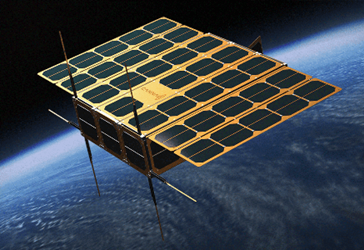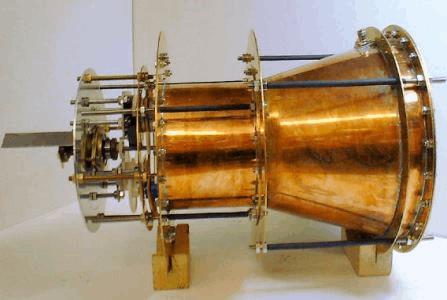NASA's Electromagnetic Drive Headed To Space: Will It Work?
By Ed Biller

NASA — an agency generally able to mathematically rationalize its every decision — is about to embark on a mission that’s anything but a “slam dunk.” They’re sending technology into space to find out if it works. Not to confirm that it works – to find out. And then, if the experiment succeeds, the agency will have to explain why it succeeded.
The agency’s “Eagleworks” — a colloquial name for NASA’s advanced propulsion physics laboratory — has explored harnessing the power of solar wind and lasers (well, photons, specifically) to propel spacecraft to their destinations. But neither of those ideas has been fleshed out enough to reach the prototype phase. However, an electromagnetically (EM) powered drive now has progressed to the point that it will be tested in space.
Initial development of the EM drive —invented by British scientist Roger Shawyer — was funded by the British government, and Boeing later licensed the technology. Since the aerospace giant’s work on the technology is backed by the U.S. military, its progress has been kept under wraps.
“To put it simply, electricity converts into microwaves within the cavity that push against the inside of the device, causing the thruster to accelerate in the opposite direction,” wrote Mary-Ann Russon, of The International Business Times, following an interview with Shawyer last year.
Enter American chemical engineer Guido Fetta. In 2006, Fetta designed a similar version of the propellant-less microwave thruster, dubbed the "Cannae Drive,” and it’s this technology that’s headed into space. While Fetta and NASA differ in their explanations of just how the Cannae Drive functions — Fetta says it derives force from a reduced reflection coefficient at one of the device's end plates, due to imbalances in the Lorentz force, while NASA claims that the cavity pushes against a "quantum virtual plasma" — they agree that it’s ready for a field test.
Within the next six months, an EM drive will be launched into space aboard a small satellite to complete its sink-or-swim test. The satellite will deposit the EM drive into a decaying orbit, which only can be maintained if the drive functions properly — no simple matter, as functioning properly requires the drive to seemingly violate Newton’s Third Law (“for every action, there is an equal and opposite reaction”) and the law of conservation of momentum.

Another explanation for how the drive functions comes from physicists at the COMSOL company, the University of Helsinki, and the University of Jyväskylä in Finland.
Their research —based on theoretical calculations — explains why the EM drive is not breaking Newton’s Third Law: "Light at microwave lengths is the fuel that's being fed into the cavity ... and the EM drive exhausts backwards paired photons. When two photons travel together, but having opposite phases, then the pair has no net electromagnetic field, and hence it will not reflect back from the metal walls, but goes through,” explained researcher Arto Annila to ScienceAlert. Those escaping photons produce the EM drive's thrust.
Most recently, a theory proposed by physicist Michael McCulloch, of Plymouth University in the UK, stated that the EM drive’s thrust is resultant of the Unruh effect, an unconfirmed concept predicted by relativity.
In short, McCulloch’s inertia theory, published on Cornell University Library's open source database, states that particles — called Unruh particles — form out of the vacuum of space, a result of the heating of the universe (around the craft) caused by acceleration. Unruh radiation particles’ wavelengths increase as acceleration decreases; as they bounce around inside the EM drive’s cone, their inertia changes, as well, ultimately resulting in thrust.
While the scientific community cannot seem to come to a consensus on the EM drive’s actual effectiveness — many researchers and academics cite large margins for error in initial testing done to prove the drive’s functionality, or that later experimental confirmations of EM propulsion simply offer explanations that cannot be scientifically accepted — answers will be swift to arrive when the drive is launched as part of a 6U CubeSat next year.
In the meantime, the American Institute of Aeronautics and Astronautics (AIAA) allegedly has accepted a paper on the EM drive, penned by NASA Eagleworks Laboratories and titled Measurement of Impulsive Thrust from a Closed Radio Frequency Cavity in Vacuum. I use “allegedly” since the confirmation of peer review came via a since-deleted blog post, and only one website has claimed confirmation of the paper’s existence/approval by AIAA. The paper is due to be published in the AIAA Journal of Propulsion and Power in December. Additionally, vibrant threads discussing/fighting over the technology have popped up on sites like NASASpaceFlight.com and, depending how far down the rabbit hole you’d like to go, Reddit.
Assuming humanity has not invested millions of dollars to launch a paperweight into orbit, the EM drive could be a game-changer (an oft-overused term, but appropriate here) for space travel. Close to home, EM propulsion could be used to maintain the International Space Station’s (ISS) orbit, or to position satellites in geostationary orbit.
The big picture, of course, is heading back to the Moon, or Mars, or even beyond the Kuiper Belt and out of our Solar System.
But first, it has to work.
I look forward to your thoughts in the Comments section below.
